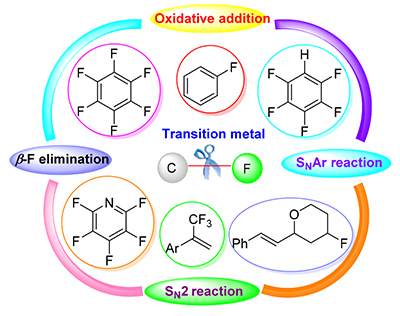摘要/Abstract

有机氟化学凭借其独特的内涵在材料科学、催化化学、医学、精细化工以及生物化学领域引起了越来越多的重视,其核心在于碳-氟键的构建和切断.过渡金属的引入为活化碳-氟键提供了新的可能,也逐渐成为合成很多复杂有机物的一种替代途径.总结了以往对过渡金属促进碳-氟键活化和切断的理论研究进展,并系统性提出了碳-氟键活化的相关模式,包括碳-氟键对金属的氧化加成、过渡金属活化的芳香亲核取代、碳(sp3)-氟键双分子亲核取代(SN2)以及β-氟消除等.理论计算表明,当使用还原性较强的零价镍催化剂时,反应可按照氧化加成模式启动.而如果使用零价铂催化剂,则需要对氟原子进行额外活化才能发生氧化加成.当使用氢化金属物种还原多氟代芳烃时,氢负离子可以与多氟代芳烃发生芳香亲核取代实现碳-氟键活化.对于碳(sp3)-氟键来说,如果使用“硬”的Lewis碱,例如锂盐或镁盐,则可按照双分子亲核取代(SN2)方式活化碳(sp3)-氟键.此外,β-氟消除也是一种可能的替代机理.
关键词: 过渡金属, C-F键官能团化, 反应机理, 氟化学
Organic fluorine chemistry has attracted considerable attention due to its unique character in the field of materials science, catalytic chemistry, medicine, fine chemicals and biochemistry, which majorly focus on the construction and cleavage of carbon-fluorine bonds. The transition metals are introduced to allow new possibilities for activating carbon-fluorine bonds and are gradually becoming an alternative way to synthesize numerous complex organics containing fluorine. In this review, the recent works on the theoretical mechanistic study for transition metals mediated carbon-fluorine bonds activation and cleavage are summarized. Meanwhile, the general modes of carbon-fluorine bonds activation have been concluded systematically, including the oxidative addition of carbon-fluorine bonds to transition metals, transition-metal-activated nucleophilic substitution, SN2 type activation of carbon(sp3)-fluorine bonds and β-fluorine elimination, etc. The theoretical calculation shows that the reaction could be proceed by an oxidation addition mode, when the zero-valent nickel catalyst with strong reducibility is employed. However, if a zero-valent platinum catalyst is used, oxidation addition only occurs at extra activated carbon-fluorine bonds. In the reduction of polyfluorinated aromatic hydrocarbons by hydrogenated metal species, aromatic nucleophilic substitution between hydride and polyfluorinated aromatic hydrocarbons could occur to realize the activation of carbon-fluoride bonds. For carbon(sp3)-fluorine bonds, if “hard” Lewis base such as lithium or magnesium salt is employed, the carbon(sp3)-fluorine bonds can be activated via bimolecular nucleophilic substitution (SN2). In addition, β-fluoride elimination is also frequently proposed in transition metal-catalyzed C—F functionalizations.
Key words: transition metal, C—F functionalization, reaction mechanism, fluorine chemistry
PDF全文下载地址:
点我下载PDF
